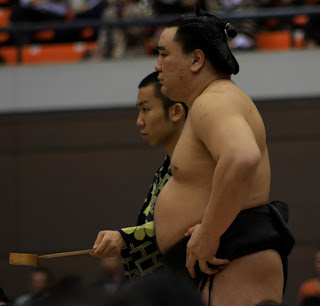Where even to begin? I love this crazy sport. It is a relic in the modern world. It is misogynistic and outdated and promotes an unhealthy lifestyle. It is rooted in the past; coming into the future slowly and reluctantly.
Yet, I love it.
The men who compete - yes, only men - do now come from all over the world. And there are amateur sumo clubs around the globe, which include women, but they do not compete against the Nihon Sumo Kyokai. Some people are even trying to make sumo wrestling an Olympic event, but the idea has not caught on.
People ask me (over and over), Why do I love it?
My answer never changes: I am a fan of history and ritual and religion. Sumo is a little of each. In sumo, each and every action has a meaning. Each turn of the hand, each stomp of the foot, each tassel on the roof over the ring, and each drum beat signifies something greater than its appearance suggests.
Sumo is all about ritual. From the ring entering ceremony to the salt and water; from the posturing to the exercises; and even the wrestling itself - it is a series of one historic ritual after another.
The ring is styled after a Shinto shrine because sumo’s origins are shrouded in the ancient religion of Japan. The many actions look like warriors battling it out because at one time they were. Turning from a religious ceremony into a training session for warriors, sumo continued to evolve. And when Japan settled into a long peaceful era of prosperity, sumo also adapted, becoming the entertainment it is today.
But evolution is not a hurried process, and these changes came about over hundreds of years. Now 1500 years old and still hanging on, I wonder how sumo will continue to evolve.
I sat in the gym on a Monday afternoon. Looking around, the place was quite naturally filled with retirees, being a workday for most of the world. I was very lucky that the tour came to Tokushima on my day off. But I wonder how many young people would have come even on a Saturday or holiday. Not many of the younger generation are as excited about sumo as I am.
The Sumo Kyokai knows that, and has already worried more than me about sumo’s future. A sport that changes slowly in a world that changes quickly seems in danger of dying. But the gym today was almost sold out, even on a Monday.
Sumo is still evolving, still changing, and still holing on to its rituals. It even draws in a new crowd of fans, younger fans. The excited four-year-old girl sitting next to us will attest to that. Right after she finishes shouting out the names of her favourite wrestlers.









No comments:
Post a Comment